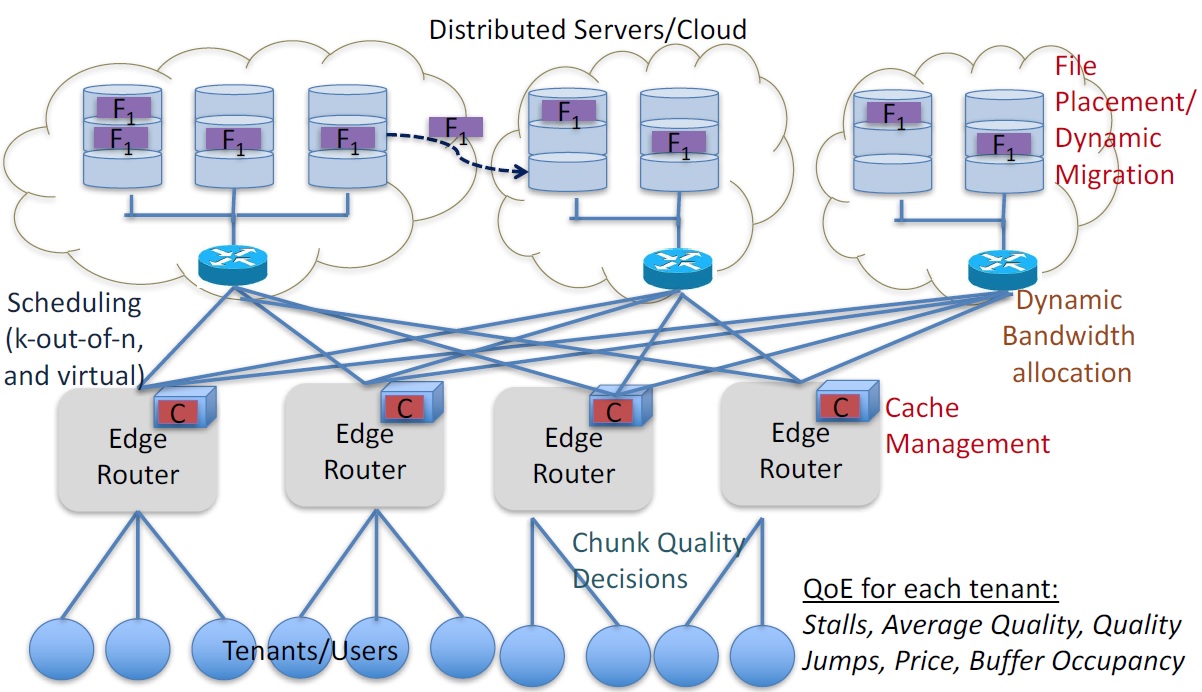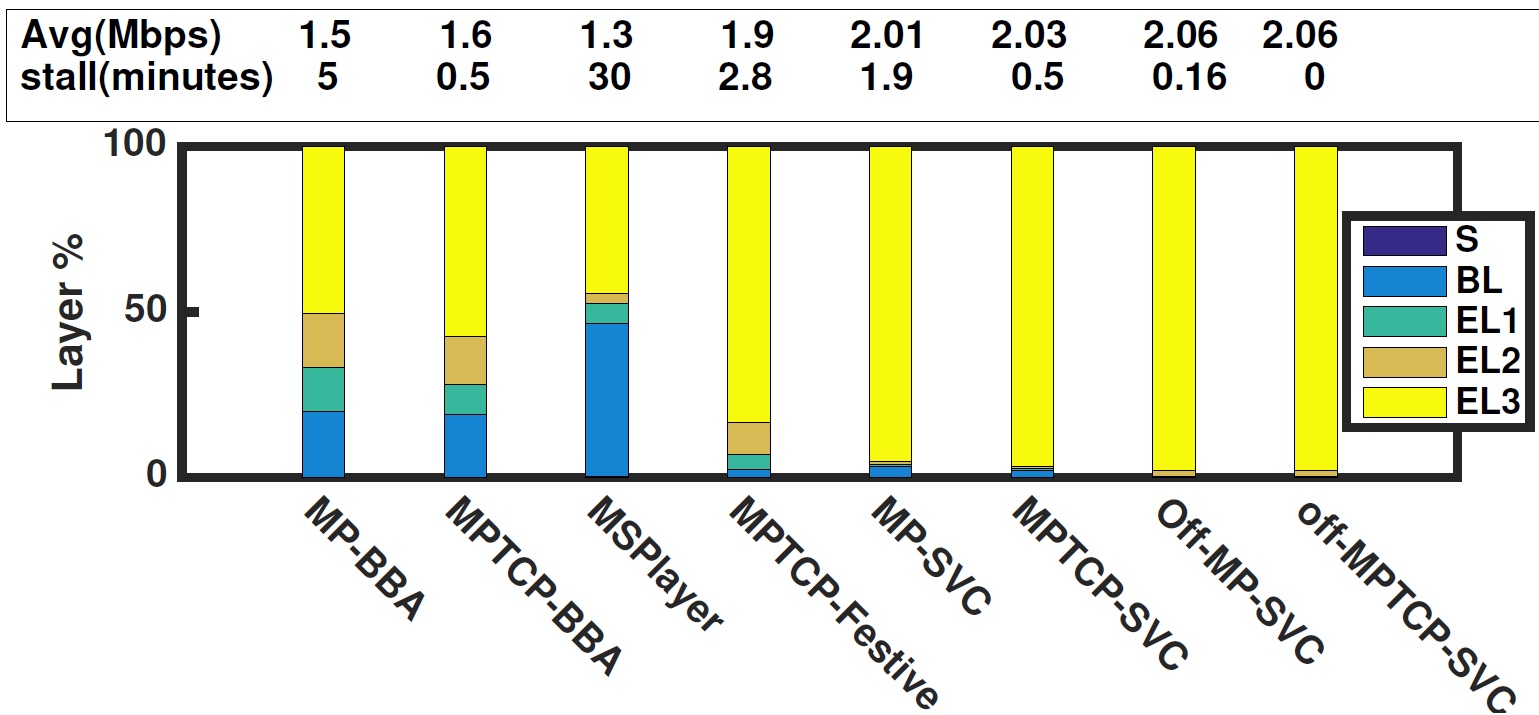Video Streaming:
Video streaming has become one of the most critical applications on the Internet. The demand for ondemand
and live content (e.g., Netflix, Hulu, ESPN), as well as for user-generated content (e.g., YouTube)
is increasing so rapidly that it is predicted that by 2019, 80% of the Internet traffic will be video, forming a
$100 billion market. The key issues in video streaming involve novel scheduling algorithms for adptive-bitrate videos. Streaming video over cloud servers make the problem challenging. Further, 360-degree videos involve additional flexibilities of using head movement prediction for scheduling, which can be exploited.

Video Streaming over Cloud:
Cloud computing has changed the way many Internet services
are provided and operated. Video-on-Demand (VoD) providers
are increasingly moving their streaming services, data storage, and
encoding software to cloud service providers. With the annual
growth of global video streaming at a rate of 18.3%, cloud-based
video has become an imperative feature of any successful business. The main challenges in video scheduling over cloud needs innovations for file placement, migration, scheduling of queues, dynamic bandwidth allocation, cache managementm and adaprive bit-rate quality decisions (as illustrated also in the figure alongside).
- A. Alabbasi, V. Aggarwal, and M. Ra, "Multi-tier Caching Analysis in CDN-based Over-the-top Video Streaming Systems," IEEE/ACM Transactions on Networking, vol. 27, no. 2, pp. 835-847, April 2019.
- A. Alabbasi, V. Aggarwal, T. Lan, Y. Xiang, M. Ra, and Y. R. Chen, "FastTrack: Minimizing Stalls for CDN-based Over-the-top Video Streaming Systems," Accepted to IEEE Transactions on Cloud Computing, Jun 2019.
- M. Panju, R. Raghu, V. Agarwal, V. Sharma, and R. Ramachandran, Queueing Theoretic Models for Uncoded and Coded Multicast Wireless Networks with Caches," Accepted to IEEE Transactions on Wireless Communication, Jul 2021.
- M. Panju, R. Raghu, V. Agarwal, V. Sharma, and R. Ramachandran, "Queuing Theoretic Models for Multicasting Under Fading," in Proc. IEEE WCNC, Apr 2019.
- A. Al-Abbasi and V. Aggarwal, "VidCloud: Joint Stall and Quality Optimization for Video Streaming over Cloud," ACM Transactions on Modeling and Performance Evaluation of Computing Systems, article no. 17, Jan 2021.
- A. Alabbasi and V. Aggarwal, "Video Streaming in Distributed Erasure-coded Storage Systems: Stall Duration Analysis," IEEE/ACM Transactions on Networking, vol. 26, no. 4, pp. 1921-1932, Aug. 2018.
- A. Alabbasi and V. Aggarwal, "EdgeCache: An Optimized Algorithm for CDN-based Over-the-top Video Streaming Services," in Proc. Infocom Workshop (International Workshop on Integrating Edge Computing, Caching, and Offloading in Next Generation Networks (IECCO)), Apr 2018.
- A. Alabbasi and V. Aggarwal, "Stall-Quality Tradeoff for Cloud-based Video Streaming," in Proc. IEEE SPCOM, Jul 2018.
- V. Aggarwal, V. Gopalakrishnan, R. Jana, K. K. Ramakrishnan
and V. Vaishampayan, "Optimizing Cloud Resources for Delivering IPTV Services through Virtualization," R-letters, vol. 4, no. 4, pp.
13-14, Aug. 2013.
- V. Aggarwal, V. Gopalakrishnan, R. Jana, K. K. Ramakrishnan
and V. Vaishampayan, "Optimizing Cloud Resources for Delivering IPTV Services through Virtualization," IEEE Transactions on Multimedia, special issue on Cloud-Based Mobile Media: Infrastructure,
Services, June 2013.
- V. Aggarwal, V. Gopalakrishnan, R. Jana, K. K. Ramakrishnan
and V. Vaishampayan, "Optimizing Cloud Resources for Delivering IPTV Services through Virtualization," in Proc. IEEE International Conference on Communication Systems and Networks (COMSNETS), Jan 2012.
- V. Aggarwal, X. Chen, V. Gopalakrishnan, R. Jana, K. K. Ramakrishnan
and V. Vaishampayan, "Exploiting Virtualization for Delivering Cloud-based IPTV Services," in Proc. IEEE Conference on Computer Communications Workshops (INFOCOM WKSHPS), Apr 2011.

Optimized Robust Video Streaming Algorithms:
Mobile video has emerged as a dominant contributor to
cellular traffic. It already accounts for around 40-55 percent
of all cellular traffic and is forecast to grow by around 55
percent annually through 2021. While its popularity is on
the rise, delivering high quality streaming video over cellular
networks remains extremely challenging. In particular, the
video quality under challenging conditions such as mobility
and poor wireless channel qualities is sometimes unacceptably
poor. Almost every viewer at some point in time can relate to
experiences of choppy videos, stalls, etc. Not surprisingly, a lot of attention from both research and
industry in the past decade has focused on the development of
adaptive streaming techniques for video on demand that can
dynamically adjust the quality of the video being streamed to
the changes in network conditions. We formulate such streaming problem as an optimization problem. Even though the optimization is non-convex with discrete variables, we show that the problem can be optimally solved with a polynomial time algorithm. This key component can be used to give streaming decisions using bandwidth prediction which is updated after each chunk download (obtained as harmonic mean or crowd-sourced learning). Further extensions with multiple paths and multi-cast framework are also important. Figure alongside depicts the significant improvements achieved by our online algorithms MP-SVC and MPTCP-SVC for multiple paths over the different baselines in the literature including BBA, MSPlayer, and Festive.
- Guanghui Zhang, Ke Liu, Mengbai Xiao, Bingshu Wang, and Vaneet Aggarwal, "Intelligent Learning Approach to Achieve Near-Second Low-Latency Live Video Streaming under Highly Fluctuating Networks," in Proc. ACM Multimedia, Oct-Nov 2023.
- Guanghui Zhang, Jie Zhang, Yan Liu, Haibo Hu, Jack Y. B. Lee, and Vaneet Aggarwal, "Adaptive Video Streaming with Automatic Quality-of-Experience Optimization," IEEE Transactions on Mobile Computing, vol. 22, no. 8, pp. 4456-4470, Aug. 2023.
- Guanghui Zhang, Jie Zhang, Ke Liu, Jing Guo, Jack Y. B. Lee, Haibo Hu, and Vaneet Aggarwal, "DUASVS: A Mobile Data Saving Strategy in Short-form Video Streaming," IEEE Transactions on Services Computing, vol. 16, no. 2, pp. 1066-1078, March-April 2023, doi: 10.1109/TSC.2022.3150012.
- G. Zhang, K. Liu, H. Hu, V. Aggarwal, and J. Y. B. Lee, "Post-Streaming Wastage Analysis – A Data Wastage Aware Framework in Mobile Video Streaming," IEEE Transactions on Mobile Computing, vol. 22, no. 1, pp. 389-401, Jan. 2023, doi: 10.1109/TMC.2021.3069764.
- G. Zhang, J. Y. B. Lee, K. Liu, H. Hu, and V. Aggarwal, "A Unified Framework for Flexible Playback Latency Control in Live Video Streaming," IEEE Transactions on Parallel and Distributed Systems, vol. 32, no. 12, pp. 3024-3037, 1 Dec. 2021.
- A. Elgabli and V. Aggarwal, "SmartStreamer: Preference-Aware Multipath Video Streaming over MPTCP," IEEE Transactions on Vehicular Technology, vol. 68, no. 7, pp. 6975-6984, July 2019.
- A. Elgabli and V. Aggarwal, "FastScan: Robust Low-Complexity Rate Adaptation Algorithm for Video Streaming over HTTP" IEEE Transactions on Circuits and Systems for Video Technology, vol. 30, no. 7, pp. 2240-2249, July 2020.
- A. Elgabli, M. Felemban, and V. Aggarwal, "GroupCast: Preference-Aware Cooperative Video Streaming with Scalable Video Coding," IEEE/ACM Transactions on Networking, vol. 27, no. 3, pp. 1138-1150, June 2019.
- A. Elgabli and V. Aggarwal, "Deadline And Buffer Constrained Knapsack Problem," IEEE Transactions on Circuits and Systems for Video Technology, vol. 29, no. 5, pp. 1564-1568, May 2019.
- A. Elgabli, K. Liu, and V. Aggarwal, "Optimized Preference-Aware Multi-path Video Streaming with Scalable Video Coding," IEEE Transactions on Mobile Computing, vol. 19, no. 1, pp. 159-172, 1 Jan. 2020.
- A. Elgabli, M. Felemban, and V. Aggarwal, "GiantClient: Video HotSpot for Multi-User Streaming," IEEE Transactions on Circuits and Systems for Video Technology, vol. 29, no. 9, pp. 2833-2843, Sept. 2019.
- A. Elgabli, V. Aggarwal, S. Hao, F. Qian, and S. Sen, "LBP: Robust Rate Adaptation Algorithm for SVC Video Streaming," IEEE/ACM Transactions on Networking, vol. 26, no. 4, pp. 1633-1645, Aug. 2018.
- A. Elgabli, V. Aggarwal, and K. Liu, "Low Complexity Algorithm for Multi-path Video Streaming," in Proc. IEEE SPCOM, Jul 2018.
- A. Elgabli and V. Aggarwal, "GroupCast: Preference-Aware Cooperative Video Streaming with Scalable Video Coding," in Proc. Infocom Workshop (International Workshop on Hot Topics in Pervasive Mobile and Online Social Networking (HotPOST'18)), Apr 2018 (Best paper award).
- V. Aggarwal, A.
R. Calderbank, V. Gopalakrishnan, R. Jana, K. K. Ramakrishnan
and F. Wu, "The Effectiveness of Intelligent Scheduling for Multicast
Video-on-Demand," in Proc. ACM International Conference on Multimedia, Beijing, China, Oct 2009.

Metrics and Adaptive Streaming Algorithms for 360-degree video streaming:
In the 360-degree immersive video, a user only views
a part of the entire raw video frame based on her viewing
direction (as shown alongside). However, today’s 360-degree video players always fetch
the entire panoramic view regardless of users’ head movement,
leading to significant bandwidth waste that can be potentially
avoided. We propose a novel adaptive streaming
scheme for 360-degree videos. The basic idea is to fetch the
invisible portion of a video at the lowest quality based on users’
head movement prediction, and to adaptively decide the video
playback quality for the visible portion based on bandwidth
prediction. Doing both in a robust manner requires overcome
a series of challenges, such as jointly considering the spatial and
temporal domains, tolerating prediction errors, and achieving
low complexity.
M. Krouka, A. Elgabli, M. S. Elbamby, C. Perfecto, M. Bennis, and V. Aggarwal, "Cross Layer Optimization and Distributed Reinforcement Learning Approach for Tile-Based 360 Degree Wireless Video Streaming," Submitted to IEEE ToT, Nov 2020 (under revision).
A. Ghosh and V. Aggarwal, "A robust algorithm for tile-based 360-degree video streaming with uncertain FOV estimation," Nov 2018.
A. Ghosh, V. Aggarwal, and F. Qian, "A Rate Adaptation Algorithm for Tile-based 360-degree Video Streaming," Feb 2018.

Estimation of QoE for the users:
Video and web applications are the most prominent applications in today's world. It is important to understand how radio network characteristics
(such as signal strength, handovers, load, etc.) influence users'
Quality-of-Experience (QoE). Understanding
the relationship between QoE and network characteristics is
a pre-requisite for cellular network operators to detect when and
where degraded network conditions actually impact QoE. Unfortunately,
cellular network operators do not have access to detailed
server-side or client-side logs to directly measure QoE
metrics, such as abandonment rate, stalls, and video/session length. We devise a machine-learning-based mechanism to infer
web QoE metrics from network traces accurately. The image alongside depicts partial web downloads as a function of network attributes. Further, heavy tails in work loads (file sizes, flow lengths,
service times, etc.) have significant negative impact on the
performance of queues and networks. There has been attempts to model work loads in head or tail of the distribution. We find that logPH distribution models both the head and the tail, since these distributions have
a power law tail and can approximate any distribution arbitrarily
closely not just in the tail but in its entire range. The figure below compares the logPH fit of the famous Internet file size data of Crovella.

- A. Balachandran, V. Aggarwal, E. Halepovic, J. Pang, S. Seshan, S. Venkataraman, and H. Yan "Modeling Web Quality-of-Experience on Cellular Networks," in Proc. Mobicom 2014
- V. Aggarwal, E. Halepovic, J. Pang, S. Venkataraman, and H. Yan "Prometheus: Toward Quality-of-Experience Estimation for
Mobile Apps from Passive Network Measurements," in Proc. Hotmobile 2014
- V. Ramaswami, K. Jain, R. Jana, and V. Aggarwal, "Modeling Heavy-tails in Traffic Sources for Network
Performance Evaluation," in Proc. International Conference on
Computational Intelligence, Cyber Security and Computational Models, Dec. 2013.
Home





